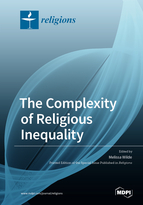The Complexity of Religious Inequality
A special issue of Religions (ISSN 2077-1444).
Deadline for manuscript submissions: closed (1 August 2020) | Viewed by 45844
Special Issue Editor
Special Issue Information
Dear Colleagues,
Although scholars of religion acknowledge religion’s deep interconnectedness with race and ethnicity in (and occassionally class), we nonetheless typically study religion as a factor that is independent from other social structures. Likewise, we rarely systematically examine class, race or gender differences between or within religious groups. This journal issue will highlight research that moves beyond these weaknesses by publishing papers that intentionally examine aspects of inequality as they relate to religion. Papers that explore these connections historically or in contemporary times and internationally or locally are all encouraged.
For more information, or to submit an abstract, please email [email protected]. Abstracts are due by January 1, 2020 and will be accepted on a rolling basis. Papers are to be submitted for peer review by June 1, 2020.
Dr. Melissa Wilde
Guest Editor
Manuscript Submission Information
Manuscripts should be submitted online at www.mdpi.com by registering and logging in to this website. Once you are registered, click here to go to the submission form. Manuscripts can be submitted until the deadline. All submissions that pass pre-check are peer-reviewed. Accepted papers will be published continuously in the journal (as soon as accepted) and will be listed together on the special issue website. Research articles, review articles as well as short communications are invited. For planned papers, a title and short abstract (about 100 words) can be sent to the Editorial Office for announcement on this website.
Submitted manuscripts should not have been published previously, nor be under consideration for publication elsewhere (except conference proceedings papers). All manuscripts are thoroughly refereed through a double-blind peer-review process. A guide for authors and other relevant information for submission of manuscripts is available on the Instructions for Authors page. Religions is an international peer-reviewed open access monthly journal published by MDPI.
Please visit the Instructions for Authors page before submitting a manuscript. The Article Processing Charge (APC) for publication in this open access journal is 1800 CHF (Swiss Francs). Submitted papers should be well formatted and use good English. Authors may use MDPI's English editing service prior to publication or during author revisions.
Keywords
- religion
- race
- class
- gender
- inequality
- ethnicity
- immigration
- sexuality






